Brötchen are THE essential part of a German breakfast, and this rustic version with sunflower seeds is my FAVORITE! Brötchen literally translates from German to 'little bread' or rolls or buns in the English language.
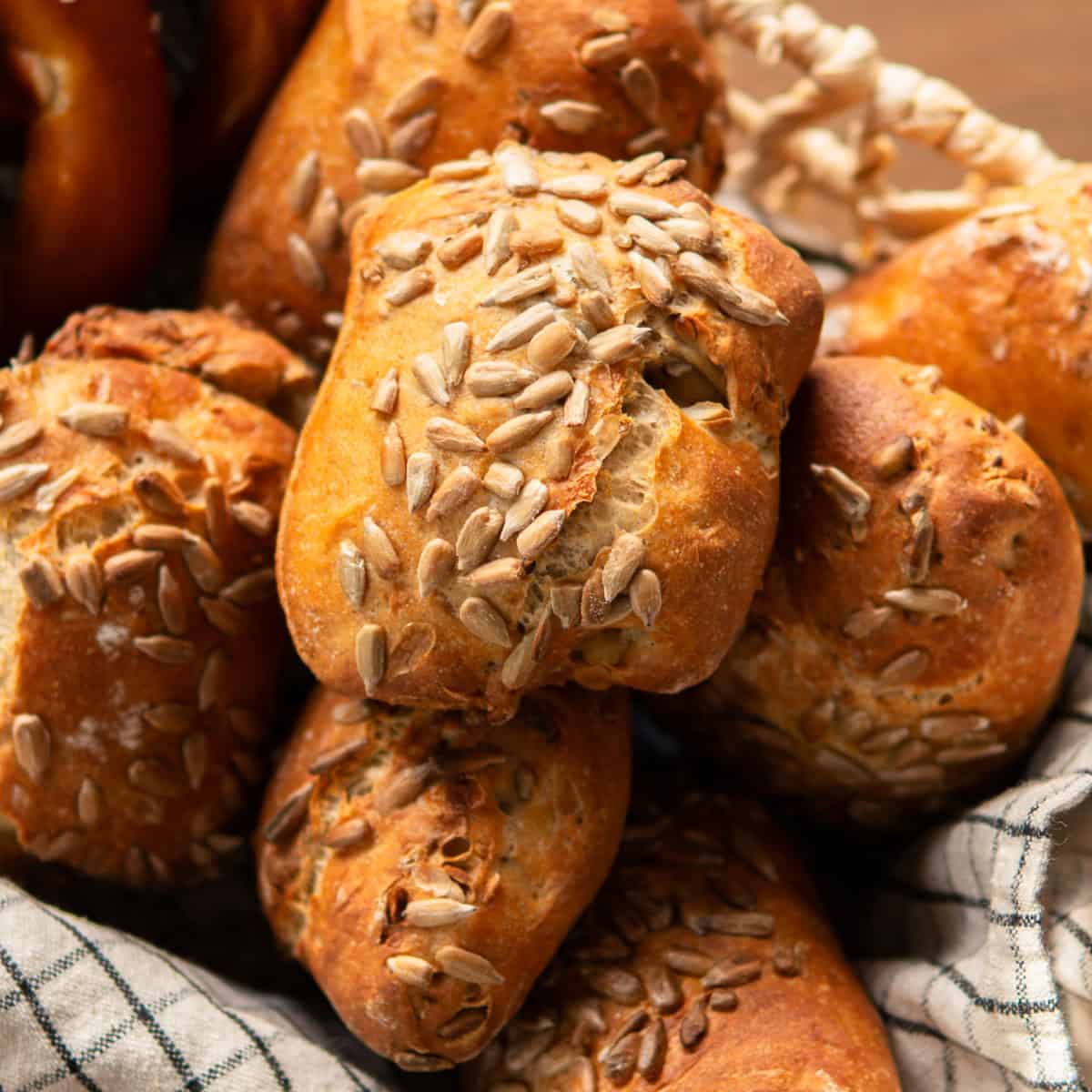
While many kinds of different Brotchen exist, these sunflower seed rolls are high up there on my list of favorite Brötchen! It also made my 11 favorite German Mother's Day brunch foods list. The soft interior and crisp crust studded with sunflower seeds are just irresistible. And then there is that dreamy bakery smell that sweeps through your entire house as these rolls crisp up in your oven. Heavenly!
Even Germans that go on vacation miss their Brötchen, 83 percent of them! Especially more whole grain version like this one because they are more difficult to find in other countries.
How to make them
This Brötchen dough uses a mixture of white wheat, semolina, and whole grain rye flours, that are combined with milk, water, and yeast. Last but not least, you add sunflower seeds at the very end. I briefly toast the seeds in a skillet, bringing out a perfect, nutty flavor.
After mixing the dough, it rests for 12 hours in the fridge overnight. Which is perfect for having these Brötchen ready for your German breakfast. They only require about 15 minutes of active work in the morning and one hour of rising time before baking.
To shape the rolls, you'll first divide them up. You'll flatten each dough piece to be a rectangle. Now you'll fold the top third of each dough piece over the middle and the bottom third up over the middle.
Press each Brötchen seam side down into sunflower rolls and let them rest seam side down on a baking sheet prepped with parchment or silicone baking mats. Cover with a clean linen towel and let them rest in a warm spot for one hour.
Now flip the rolls over, so the sunflowers show on the top and bake according to the recipe instructions below.
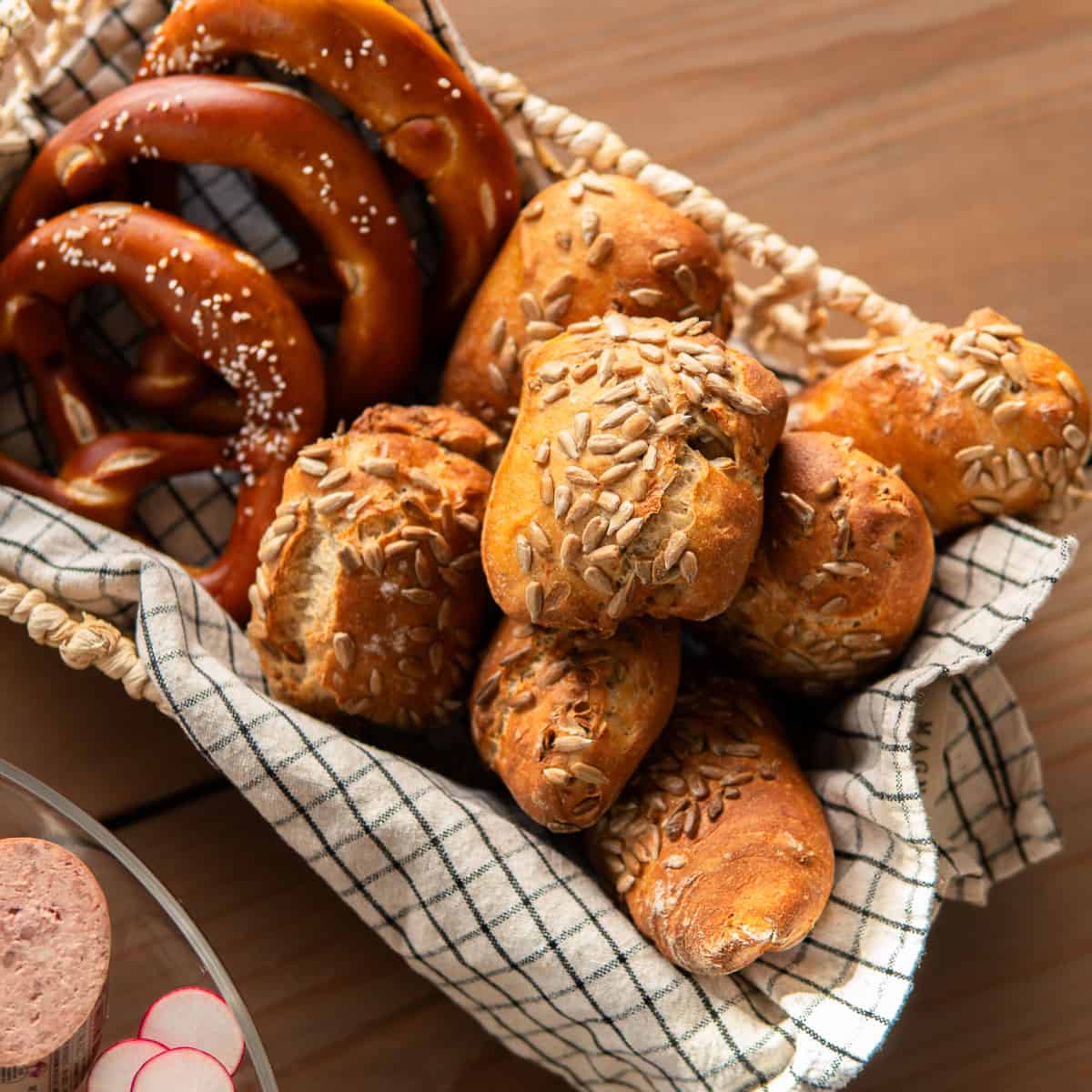
It's a must-try recipe for anyone who misses German bakery bread, especially Brötchen.
Ingredients
You only need a few ingredients to make these German rolls with sunflower seeds, and you may already have some of them at home.
- Sunflower seeds. I use raw sunflower seeds. I briefly toast them before adding them to the dough for extra nutty flavor. I leave the seeds raw when rolling the Brötchen in before the final rise. This way they don't burn in the oven.
- White wheat flour. I use all-purpose flour.
- Whole rye flour. You can also use whole wheat flour or spelt flour instead.
- Semolina flour. You could use whole-grain flour (wheat, spelt or rye) instead of semolina in this recipe.
- Oil. I use avocado oil, but any flavor-neutral oil will work well in this recipe.
- Yeast. I use active-dry yeast for my Brotchen and all of my baking recipes.
- Milk. I use whichever kind of milk we have on hand, which is usually 2 percent or whole. Dairy-free milk will work, too.
- Salt. Just a little bit of salt is used in these rolls and I use pink sea salt.
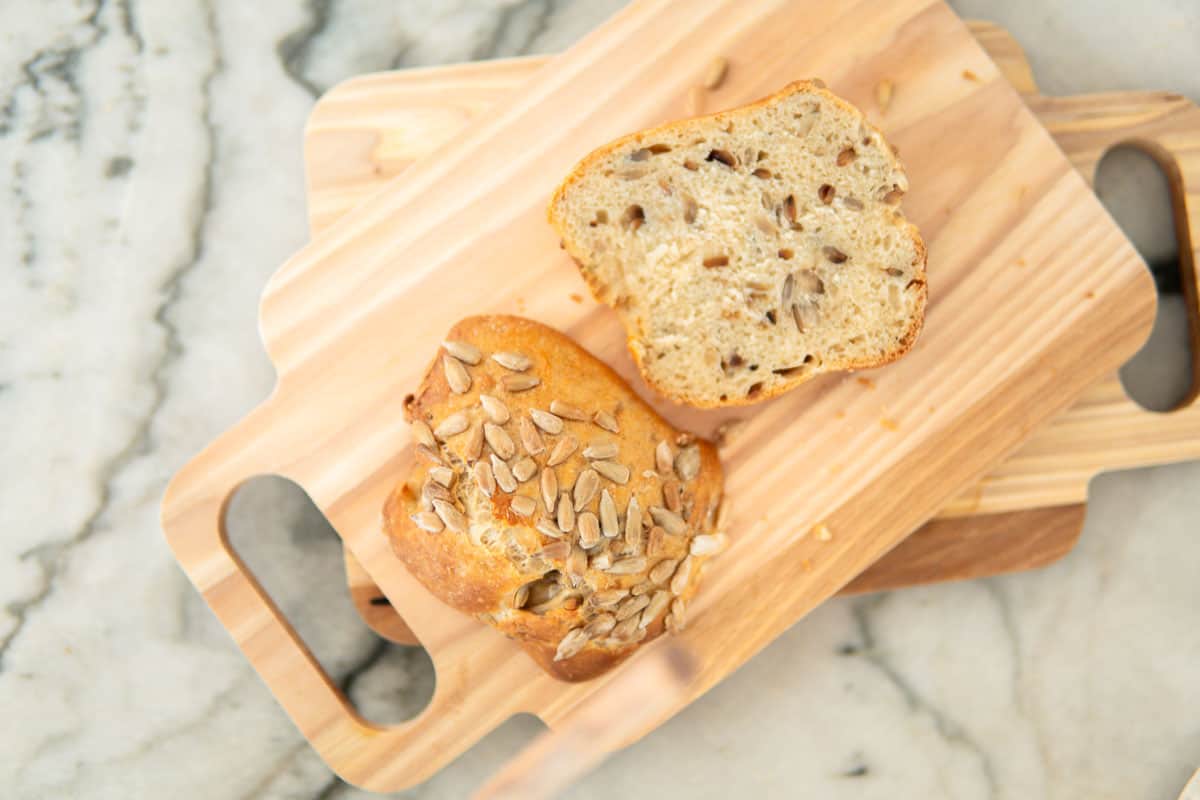
More Brötchen recipes
Feel like your Brötchen basket is a bit empty and you want to add more? Try my Weizenbrötchen (German white rolls), Müslibrötchen (German granola rolls), and Laugenbrötchen (German pretzel buns).
Then read about what else you will need to make your Frühstück (German breakfast) complete.
The first food I need to have in Germany
Whenever I go visit my family in Germany, I haven't fully arrived until I have taken a bite from a fresh Brotchen as part of a German breakfast or Frühstück.
So you can imagine that having come up with this Sonnenblumenkernbrötchen (sunflower seed roll) recipe is such a soothing recipe to have when I haven't been able to visit home in a while.
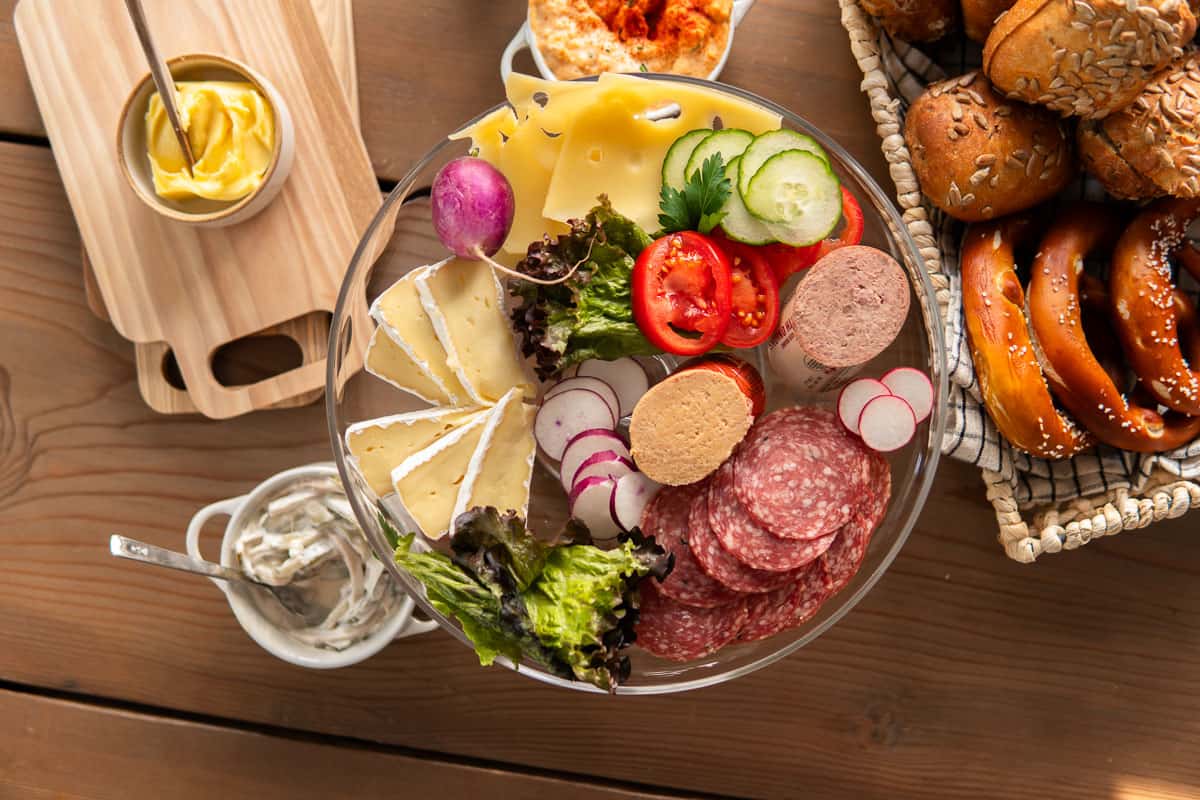
For those wondering, Döner Kebab is a super close second place that I have to have after arriving in Germany. And randomly I will have it before I have a Brötchen. I know. I also have a recipe for an authentic Döner that you MUST TRY.

Brötchen (German rolls with sunflower seeds)
Ingredients
Dough
- 7 grams active-dry yeast 1 pouch
- 150 grams milk at about 40° C/104° F
- 150 grams water at about 5° C/41° F
- 235 grams all-purpose wheat flour white wheat flour, plus more for shaping
- 100 grams semolina flour can use whole wheat flour instead
- 55 grams whole-grain rye flour can use whole wheat flour instead
- 8 grams sea salt
- 8 grams oil a flavor neutral oil like avocado oil, but olive oil works too
- 75 grams sunflower seeds dry-roasted in skillet
Toppings
- 100 grams sunflower seeds raw, not roasted
Instructions
- Combine yeast and barely warm milk and allow to sit and activate for 5 minutes. If it doesn't start to bubble up after 5 minutes, start over.7 grams active-dry yeast, 150 grams milk
- Combine all ingredients for the dough, except for the sunflower seeds and knead for 10 minutes on the lowest setting.Then increase to a medium setting and knead 5 more minutes. The Brötchen dough should be smooth and elastic and pulling away from the sides.235 grams all-purpose wheat flour, 100 grams semolina flour, 55 grams whole-grain rye flour, 8 grams sea salt, 8 grams oil, 75 grams sunflower seeds, 150 grams water
- Put the dough in a bowl and cover air-tight. Move to the fridge and allow to proof for 12 hours (easiest to do this overnight). It should have doubled in size.
- Lightly dust your work surface with all-purpose flour. Transfer the chilled dough onto the floured surface. Shape into an even thickness log. Then divide it into 8 equal pieces of dough. (I cut it in half first and then each half into 4 pieces.)
- Working with one dough piece at a time, press down on the dough with a flour-dusted palm, so it's elongated. Take one of the short thirds, and fold it over itself, pressing down with the palm again, and repeat folding the other third over itself.You will end up with 3 layers of dough on top of each other. Press down on it with your palm to seal the seam. Repeat this step with all the other dough pieces.
- Pour the seeds for the toppings in a bowl. Press the rolls into the seeds from all sides, so that they stick to the dough. If they are not sticky enough, brush or spray them with a bit of water and then try again. Transfer the rolls onto a baking sheet prepped with parchment paper or silicone baking mat.Cover loosely with a clean linen towel and allow to rise for 1 hour in a warm spot in your house.100 grams sunflower seeds
- In the meantime while the Brötchen are rising, preheat the oven to 230° C/445° F and put a large pan filled with warm water on the bottom rack of your oven. This will create steam as the oven heats up.
- Spray or brush the Brötchen with some water, and bake for 10 minutes (total baking time will be 20 minutes), leaving the pan filled with water in the oven.After 10 minutes, open the oven door wide for a few seconds to allow the steam to escape. You may want to not look or else you're getting a hot facial! Then close the oven door, and bake for 5 minutes, leaving the pan with water in the oven.For the last 5 minutes of baking, leave the oven door open at a gap OR remove the pan with water. This will ensure a browned, crisp surface. Enjoy the amazing scents.
- Transfer your cute little Brötchen a cooling rack and leave uncovered until cooled completely. Enjoy for a German Frühstück.


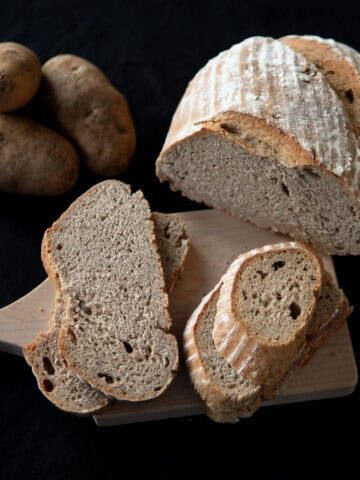


Rea
Please clarify step 6 on how to shape the buns. Your description is a little convoluted to me. Do you mean folding the log of dough up into thirds, like one would fold up a letter onto itself.
dirndlkitchen
Yes, it's hard to explain. I will add some additional photos soon, but the letter-folding analogy is really helpful! Thank you and I hope you loved them! Sophie
Nishan
My partner is German and I've been using this recipe for our last few bakes. Always turned out well and if not, a little bit dry! But I am a beginner breadmaker myself so maybe it will take some time for me to get used to the process. Today I'm baking it as a whole loaf for the first time. We'll see how it turns out! 😉
dirndlkitchen
Oh, I've never baked these Brötchen as a whole loaf, but can't wait to hear what you think!
Rodney Boehme
My cousin lives in Austria and when I visit, I love the rolls from the supermarket bakery. We have them every morning at breakfast. He likes the semmels, but I really like the more heavy and seedy bread rolls. These sunflower rolls turned out great. Everyone loved them. I substituted whole spouted wheat flour for the semolina, but didn't change anything else in the recipe or directions. They are just as good as what I've had in Austria.
dirndlkitchen
Rodney, thank you so much for your amazing feedback for my German sunflower seed Brötchen recipe! I can't wait for you to try many more Brötchen recipes soon! Sophie
Deanne Puder
These turned out perfectly! So easy and so good!
Sophie Sadler
Deanne, I'm so happy to hear that you loved my Brötchen recipe. Thank you for the kind review!
Manja
Hello, do you use fanforce or conventional oven setting? Thank you
dirndlkitchen
Hi Manja! I use the conventional oven setting (Ober-/Unterhitze) with this Brötchen recipe! I hope you'll love it! I made them again today to gift to some friends and they all loved them!